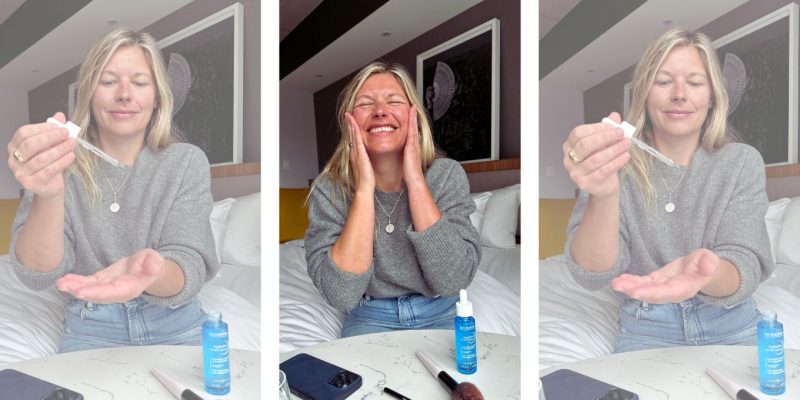Stacie Brockman was 12 years old when she suffered her first migraine. “I was at school, vomiting violently for hours, screaming at the top of my lungs in the most excruciating pain and trying to keep any sort of medication down while I waited for my mom to pick me up,” recalls the New York- based Canadian co-founder of advertising agency Métier Creative, who has since been diagnosed with severe chronic migraines. Now 29, she describes the sensation of an on-coming migraine as like being inside a glass box. First comes a visual aura—sharp lines or squiggly dots that shadow her vision – followed by numbness that crawls up her legs and arms. “I get completely disoriented. I know that I’m physically present, but everything sounds muffled, like when you put your hands over your ears,” she explains. “That’s the most terrifying 60 to 120 seconds.”
Surprisingly, this is not an uncommon story among women. (A plot line on the last season of Keeping Up With the Kardashians even followed Khloé Kardashian’s attempts to deal with her migraines.) According to 2015/2016 research from Statistics Canada, three million Canadians have been diagnosed with migraines by a health-care professional. Other research estimates that over 80 percent of them are women. That staggering statistic doesn’t even account for women who, like myself, have never been diagnosed. I excel at the primarily female practice of telling myself that what I’m experiencing isn’t really that bad, even though, in reality, there are four-ish days a month when I wake up, go about my day, go to sleep and wake up again with a consistent, throbbing pain that wraps around my head like an invisible bucket hat.
“Knowing that pain can descend at any time stirs up gut-churning anxiety. After all, how can you properly prepare for a client presentation when you feel the early tingles of disorientation setting in and know that control is slowly slipping away?”
Although many of us use “migraine” colloquially to describe a headache, there is a clinical difference between a headache and a migraine. (Which is no doubt why migraine sufferers were annoyed by the so-called “migraine pose” – one hand placed on the temple as if in response to pain but actually just for its flattering effect in a photo – that became popular on Instagram last year.) A migraine isn’t a one-off incident. It’s a recurring neurological condition of varying frequency that can even be chronic, affecting some for more than 15 days a month. Most people with a headache can carry on with their day; a migraine is disabling.
“It’s really difficult for people to understand how complex and debilitating migraines can be,” says Brockman, who has been forced to miss engagement parties, her best friend’s wedding and major work meetings. Knowing that pain can descend at any time stirs up gut-churning anxiety. After all, how can you properly prepare for a client presentation when you feel the early tingles of disorientation setting in and know that control is slowly slipping away? “No one wants to feel weak in business or in life, but as women we feel like we have a lot to prove,” she says. “We struggle with the idea of weakness.”
We may, however, suffer more from migraines precisely because we are women. Estrogen, the primary female sex hormone, which fluctuates throughout the menstrual cycle and is highest during women’s most fertile years, is likely the culprit. A 2018 study suggests that estrogen sensitizes the cells around a major nerve and the surrounding blood vessels, making them more susceptible to migraine triggers. On the other hand, testosterone, a male sex hormone, was found to actually help prevent those same sparks. In their findings, researchers noted the need for more studies that focus on human models rather than test tubes or animals—a particularly noteworthy statement when you consider that, historically, medical research has been done on males.
“Think of a stereo system blasting loudly. That’s a migrainer’s nervous system: overcharged and constantly firing. In order to calm those headaches down, you need to decrease the volume.” Botox helps quiet the pain signals.”
Because, while most drugs are created by big pharma with a one-size-fits-all mindset (that is, one that ignores how female physiology differs from that of males), migraines can’t be treated with a uniform treatment plan, says Dr. Ian Finkelstein, medical director at the Toronto Headache & Pain Clinic, who has been working with migraine, headache and chronic-pain patients for over two decades. When meeting with a new patient, Finkelstein spends a minimum of an hour taking their history, ruling out potential underlying causes and making a diagnosis. Then he sifts through the available treatment options: There are acute medications, meaning you take them when you get a migraine attack, and preventive medications, both oral and injectable. “We have to work with the patient,” says Finkelstein, noting that some patients, for instance, do not want to take oral meds. In those cases, Botox is an exciting option. The neuromodulator, which prevents muscle contractions, can be used cosmetically to soften a furrowed brow or lines around the eyes. In 2011, however, it was approved by Health Canada for the treatment of chronic migraines as it is effective in decreasing their frequency and severity. The therapeutic protocol is specific: 155 units, which is about 31 injections, placed into seven regions across the head, neck and shoulders.
“Think of a stereo system blasting loudly,” says Finkelstein. “That’s a migrainer’s nervous system: overcharged and constantly firing. In order to calm those headaches down, you need to decrease the volume.” Botox helps quiet the pain signals. Though people use “Botox” as a branded catch-all for neuromodulators in the same way that “Kleenex” has come to mean tissues, Botox is the only neuromodulator for which there is approved dosing for chronic migraines. But, like any drug, it won’t work for everyone.
“Is my pain just something that comes along with having a menstrual cycle? It’s just a few days a month, right? I could suck it up.”
Keeping a migraine diary and taking time to reflect on what’s happening in your life and your responses to it and sharing that with a medical professional is instrumental in getting effective treatment, advises Brockman. “No one knows your body better than you.” But tracking your symptoms and advocating for your health feels cumbersome when you’re already struck down with throbbing pain. “Patients are waiting for their consultation [with a headache specialist], and all the time they’re suffering,” says Finkelstein, who explains that family doctors aren’t always equipped with the time and resources to treat migraines. “Their life is being affected, and they can start to take too much medication by the time we see them.” (The upper limit on taking any acute medications, including over-the-counter ones, is 10 days a month; going over that comes with the risk of rebound headaches.)
I’m not completely incapable of advocating for my own health, I often tell myself. I’ve spoken to my family doctor about my headaches. I’ve done tests to rule out “serious” causes. But the route to seeing a specialist—asking my doctor to make a referral, following up to make sure my referral has been received, booking an appointment for months down the line that fits into my work schedule—is complex and leaves me time to stew in the doubts that affect so many women. Is my pain just something that comes along with having a menstrual cycle? It’s just a few days a month, right? I could suck it up. And then I remember a recent gala dinner where I was a guest of an important business partner; I had to leave before the main course because the pain radiating down from my head and through my entire body was so severe I thought I might vomit on my seatmate. That memory is enough to prompt me out of my complacency and remind me that pain might be subjective, but it doesn’t need to be accepted.
What Can You Do Right Now?
The effect lifestyle choices can have on migraines is significant. “People minimize that,” says Finkelstein. Here are his recommendations.
Do not skip meals.
“Migrainers need a large protein load – 20 grams within half an hour of get- ting up in the morning.” (To get a sense of that amount, consider that one egg has six grams of protein.)
Hydrate.
“Drink a lot of water throughout the day. I hear about patients going on long flights and getting a brutal migraine. Why? It is dehydrating up there.”
Develop a sleep routine.
“Same time to sleep, same time to get up. A lot of chronic migrainers who are not feeling well will sleep through the day. That’s a bad idea.”
Exercise.
“Exercise releases natural endorphins. Try going for a walk for 20 to 30 minutes.”
Be mindful of caffeine intake.
“It’s a double-edged sword. Some people find it beneficial for treating the migraine, others don’t. We don’t want people to overconsume caffeine.”
Vitamins.
“Magnesium, vitamin B2 and coenzyme Q10 all have lots of evidence behind them. The problem is that chronic migrainers don’t respond as well to that as episodic migrainers do.”
A version of this article originally appeared in the November 2019 issue of ELLE Canada.
Newsletter
Join our mailing list for the latest and biggest in fashion trends, beauty, culture and celebrity.
Read Next
Fashion
The Most Iconic Looks In Met Gala History, From 1973 To Now
40 years of the night that's all about trailblazing fashion.
by : ELLE Australia- Apr 24th, 2024

Beauty
Dr. Idriss Skincare Is Finally Available in Canada
We chatted with the internet's favourite derm about her routine, overrated (and underrated!) skincare advice and why butt paste is her secret cure for inflamed skin.
by : Melissa Fejtek- Apr 24th, 2024

Beauty
Tested and Approved: Your New Hydrating Skincare BFF
This new product has all of your skin’s thirst-quenching needs covered.
by : ELLE Canada- Apr 17th, 2024



